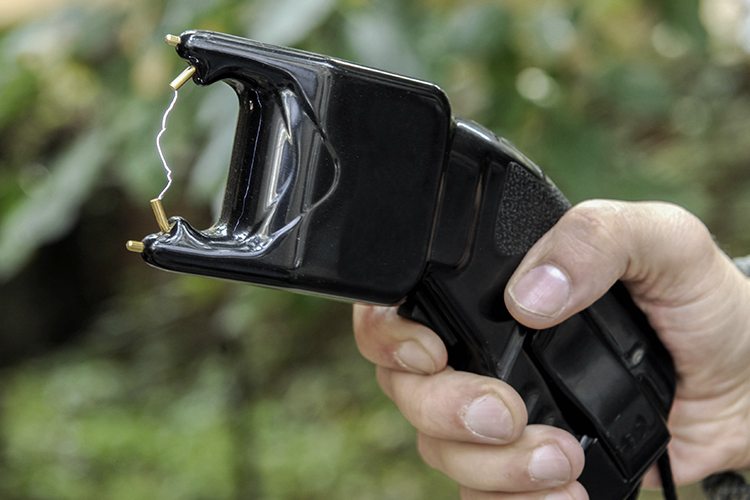For better or worse, TASER is one of the most famous names in stun guns. Many people routinely use the terms “to taser” or “tasering” when talking about the use of nonlethal force by police officers. But it’s not a generic word. TASER is an acronym and a trademarked brand for a particular type of conducted energy weapon (CEW).

Cattle Prods
The technology for stun guns has been around for some time, but it was mostly used for cattle prods and similar tools. During the Civil Rights era, police officers used cattle prods to control crowds. Public outcry over the use of these “shock batons” led to demands for a weapon that could control people without causing serious or permanent harm.
In 1970, Jack Cover answered the call with a handheld device that used similar technology. Cover was an aerospace engineer at the National Aeronautics and Space Administration (NASA). He said he got his idea from two sources. First, he read a newspaper article about a hiker who accidentally ran into an electrified fence and survived. Second, he said he had always been inspired by a Tom Swift novel he read as a boy.
Inspired by Tom Swift
The Tom Swift books were children’s adventure stories that featured Tom, a young science and technology whiz who was “swift in name and swift in nature.” The book that inspired Cover was the 1911 title, Tom Swift and His Electric Rifle. In fact, Cover used the first letter of each word in the title to name his invention: TASER.
Cover’s invention put the power of electricity into a small, handheld model. In 1974, he patented the design for his TASER stun gun. The government classified it as a weapon, however, because it used gunpowder to fire the electricity. There were also some design flaws. Even when police officers used it—most famously in the Rodney King incident in 1991—the TASER didn’t work as promised.
Revamping the Design
In 1993, he joined forces with another inventor, Patrick Smith, who proposed a redesign of the TASER. In the new version, the device used compressed air instead of gunpowder. That change meant the TASER could now be marketed as a protection device and not as a firearm.
Smith and his brother Tom founded TASER International in 1993 and began marketing the device to law enforcement departments. The device became popular among police departments looking for alternatives to deadly force. Today, more than 13,000 police departments across the country include TASERs as part of their equipment.
Is It Becoming Generic?
Although many people use “TASER” to refer to any stun gun, the name is a registered trademark of TASER International. Like other companies whose trademarks have become famous, TASER faces the possibility of losing its trademark rights to “genericide.”
Genericide is a legal phenomenon that happens when a trademarked name is so famous that it becomes the generic term for something. Some famous brands that were once trademarked include aspirin, dumpster, cellophane, dry ice and thermos. These brands lost their trademark status are now considered generic.
How do well-known companies protect themselves from this fate? They do it largely in three ways. First, they insist on using the correct term and spelling in all their corporate communications. Second, they monitor use of the term by the media, by retailers and by resellers of their products. Third, they take legal action when necessary.
TASER routinely monitors the use of its name to ensure TASER is spelled correctly and capitalized. The company has been quick to respond to all patent and trademark infringements.
Suing Second Life
In 2010, TASER sued the creators of the popular Second Life online virtual world. One of the features of Second Life is the ability to use in-game currency to purchase virtual items. TASER alleged that the game was letting buyers purchase virtual TASER weapons and said this caused damage to its reputation. Second Life responded by removing the virtual TASERs from its platform, and TASER dropped the lawsuit.
In 2016, TASER sued a Taiwanese company named PhaZZer for trademark infringement and unfair competition. TASER charged that PhaZZer was selling stun gun darts that were just like the trademarked TASER darts. A judge ruled in TASER’s favor. PhaZZer appealed, and a U.S. Court of Appeals ruling upheld the lower court verdict.
In 2020, PhaZZer announced it was filing for bankruptcy. It blamed TASER’s “costly litigation tactics.” The company noted that it still had active licensing agreements with other companies and predicted, “Those new companies won’t get picked on regarding those patent claims like we did.”
TASER Takes on Stinger
TASER held a long-running legal battle with another stun gun manufacturer named Stinger. Stinger, which was based in Charlotte, North Carolina, had long claimed its stun guns were superior in quality to TASER’s. In 2004, the company offered a “TASER trade-in” to police departments, saying its CEWs were cheaper, safer and more accurate.
TASER responded with a lawsuit alleging false advertising and unlawful patent marketing. Stinger filed a counterclaim saying that TASER’s lawsuit was aimed at stifling a competitive marketplace.
Over the next few years, both companies filed a series of lawsuits. In 2008, TASER alleged that Stinger had made false claims in a press release that stated the U.S. Patent Office was reexamining TASER’s trademark status. In the press release, Stinger said this was a sign that TASER might lose its trademark. TASER responded with another lawsuit alleging defamation, and the court ruled in Stinger’s favor.
Claims and Counterclaims
The legal battle raged on until 2012. It was marked by colorful language, including TASER’s allegation that the Stinger was a “fictitious device” and Stinger’s invitation to conduct a duel between the two devices to see how “fictitious” it was. It got so bad that a judge in one ruling admonished both sides about their language.
In the final disposition, TASER prevailed, and Stinger was ordered to stop making or selling its devices. Undeterred, Stinger owner Robert Gruder later formed Karbon Arms, another competitor in the CEW market.
Read up on more common word trademarks.
Final Judgment
Litigation between the companies continued. An initial lawsuit filed in Arizona was decided in Karbon’s favor. In 2014, however, the litigation ended when a federal judge ruled in TASER’s favor. The decision ordered Karbon Arms to pay TASER $2.4 million for patent infringement violations. Karbon Arms was also permanently enjoined from making similar items.
In an interview, Gruder said the amount was more than his company could handle after years of litigation, and that was the end of Karbon Arms. Gruder left the stun gun business entirely.
TASER’s willingness to engage in aggressive, protracted legal battles shows how important a trademark is. While it’s true that not everyone has the financial and legal resources TASER does, it’s also true that proactive measures can protect any brand from turning into a generic term.

